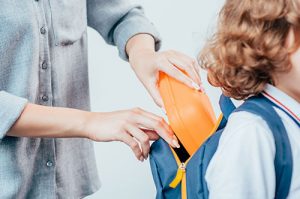Heavy, poorly designed and poorly packed backpacks can all contribute to straining your child’s back. We have tips on backpack safety for parents to help you prevent this.

What to look for when choosing a backpack for your child
- Please choose the right size for your child while allowing enough space for what they need. It is tempting to buy a child’s backpack large so that it will see them through the primary school years. However, the size of a prep student is very different from the size they may reach by grade 6. The bottom of the pack shouldn’t reach more than about 10 cm below their waist and not be wider than their chest.
- The straps should be wide and well-padded to relieve pressure over the shoulders.
- The back of the pack should be firm with preferably some padding and contouring to sit comfortably against your child’s back.
- Packs that have a partition are best as they prevent items from sliding around and pulling on your child’s back.
The safe way to pack and fit a backpack
- Place the heaviest items, such as books, laptops and tablets closest to your child’s back, i.e. the back of the pack. If the pack has two compartments, place heavy items in the compartment closest to your child’s back
- Distribute weight evenly over their back by instructing them to wear the pack over both shoulders and not sling it over one shoulder. This can cause them to lean to one side and place more pressure on one area.
- Make sure the backpack is not too heavy. It should not weigh more than 10% of your child’s weight. Eg. If your child weighs 45kg, the backpack should weigh no more than 4.5kg. On the odd occasion that the backpack is too heavy and full, your child can carry an item in their hands.
- Check what your child has in their pack and remove any items that aren’t necessary for that day’s activities.
- Adjust the shoulder straps so that the pack fits snug against your child’s back. If it is worn loosely and hangs low it will pull your child backwards or they will bend forwards to counteract the backward pull. Either way, it can lead to muscle strain.
- The bottom of the pack should rest in the curve of the lower back
- Using the waist belt on the pack is the best way to distribute weight more evenly by taking the weight off the shoulders and distributing some through the pelvis.
